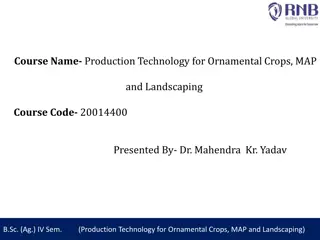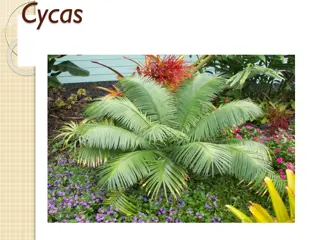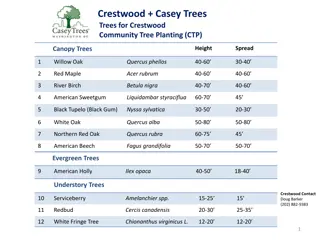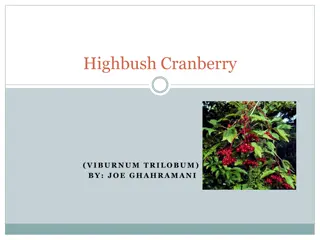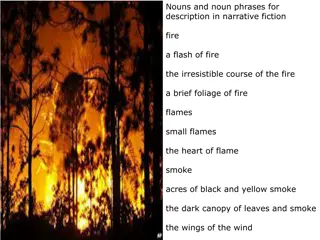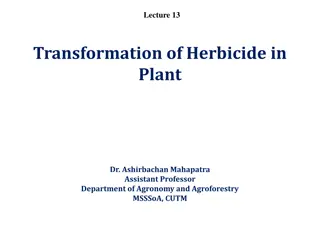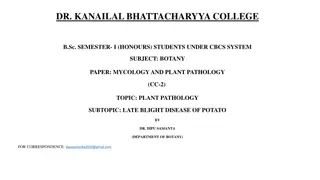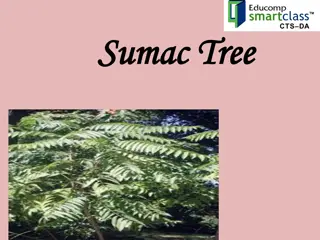Luxury Safari Accommodation To Discover The Iconic Wildlife And The Natural Envi
Going on safari means stepping into a world where the heartbeat of nature echoes through the air. Every sound emanating from the foliage conceals a hidden mystery yearning to be discovered.\n\nFor more info visit: \/\/ \/kenya-safaris\/6-days-kenya-semi-luxury-safari
2 views • 6 slides
Production Technology for Ornamental Crops and Landscaping Overview
Explore the world of ornamental crops, medicinal plants, and landscaping with Dr. Mahendra Kr. Yadav's Production Technology course. Learn about different crop types, landscaping principles, flower production practices, and the importance of value addition. Delve into ornamental horticulture, floric
0 views • 15 slides
Understanding Cycas: A Detailed Look at the Morphology and Characteristics
Sixteen species of Cycas are distributed across tropical and sub-tropical regions, with India hosting six species. Cycas plants are evergreen and resemble palm trees, with unique root and stem structures. The plant body consists of an arborescent stem and distinctive leaf morphology. Cycas leaves ar
0 views • 26 slides
Crestwood Community Tree Planting - Tree Species Overview
Explore the diverse range of trees recommended for the Crestwood Community Tree Planting project. From majestic oaks to colorful maples, each species brings unique characteristics and benefits to the urban landscape. Learn about their heights, spreads, foliage colors, and preferred conditions to mak
1 views • 13 slides
Comprehensive Guide to Highbush Cranberry (Viburnum trilobum)
Highbush Cranberry, known scientifically as Viburnum trilobum, is a deciduous shrub that grows up to 12 feet tall. It features dark green leaves in summer and maroon foliage in fall, white flowers, and bright red or orange fruits that persist through winter. This plant thrives in moist and slightly
0 views • 7 slides
Honey Bee Exposure to Pesticides: Routes and Impacts
Analysis by the U.S. Environmental Protection Agency outlines various exposure routes of honey bees to pesticides, including contact with contaminated sources like foliage and soil, ingestion of contaminated pollen and nectar, and inhalation of chemical droplets. Different application types and age
2 views • 13 slides
The Influence of the West Wind on Nature: A Visual Journey
The poetic verses of "Ode to the West Wind" by Percy Bysshe Shelley vividly depict the disruptive and transformative impact of the West Wind on nature. Through captivating imagery, the poem portrays how the West Wind stirs the Mediterranean sea from its slumber, creates chasms in the Atlantic Ocean,
1 views • 20 slides
Raging Fire in the Forest: A Narrative Description
Smoke and flames engulf a forest in a vivid narrative, with verbs like festooned, stirred, and flaring bringing the scene to life. Readers witness the thrilling progression of fire through trees and foliage, evoking a sense of both danger and awe. The descriptive nouns and phrases enhance the imager
0 views • 4 slides
Herbicide Absorption and Translocation Mechanisms in Plants
Herbicides need to be effectively absorbed and translocated within plants to interfere with physiological and biochemical processes. Soil-applied herbicides are absorbed by roots, shoots, and seeds through different mechanisms, while foliage-applied herbicides enter through the cuticle, stomata, and
0 views • 7 slides
Late Blight Disease of Potato: Symptoms and Management
Late blight is a severe fungal disease affecting potatoes worldwide, causing foliage damage, reduced tuber yield, and decay. It is caused by Phytophthora infestans and manifests as brownish-black lesions on plant parts. The disease spreads rapidly under humid conditions, leading to blighting of foli
0 views • 8 slides
Flower Value Addition in Mamillapalli Thriveni
Value addition in flowers is a process that enhances the economic value and consumer appeal of floral commodities through genetic changes, processing, packaging diversification, and postharvest technology adoption. It not only boosts profitability but also serves as a rural development strategy, esp
0 views • 25 slides
Exploring Leaves: From FOLI to Unifoliate
Delve into the world of leaves, from the beautiful FOLIage of plants to the use of defoliants and folio in literature. Discover the significance of bifoliate orchids, the importance of folic acid, and the art of exfoliating leaves. Explore the diverse meanings and applications of leaves in various c
0 views • 11 slides
All About Sumac Trees: Features, Uses, and Care Tips
Sumac trees, known for their shrubs and small trees with clusters of reddish drupes, are commonly found in North America and Africa. These trees, comprising approximately 250 species, are used for landscaping but some species can cause skin irritation. With minimal care requirements, sumac trees can
0 views • 11 slides
